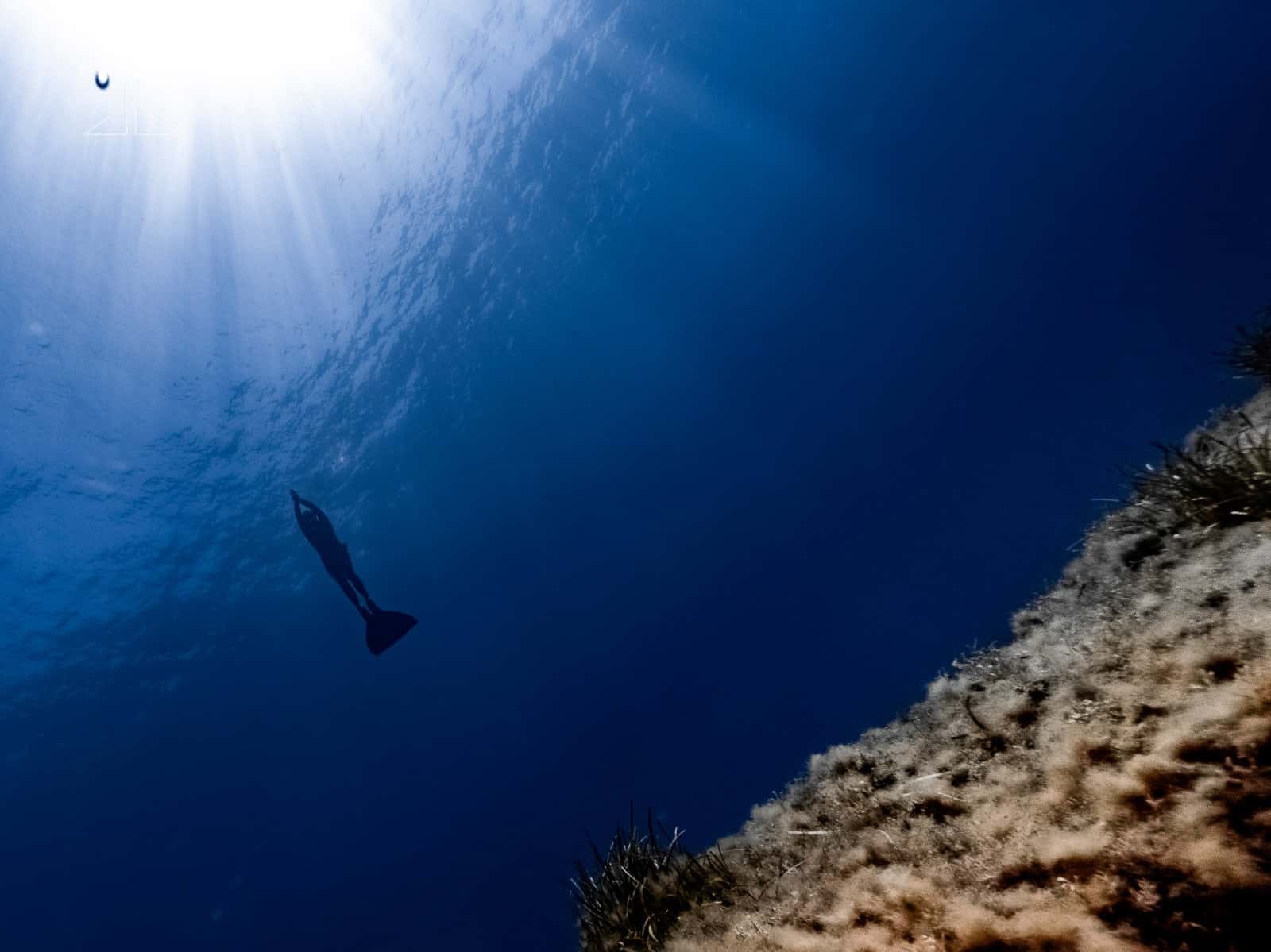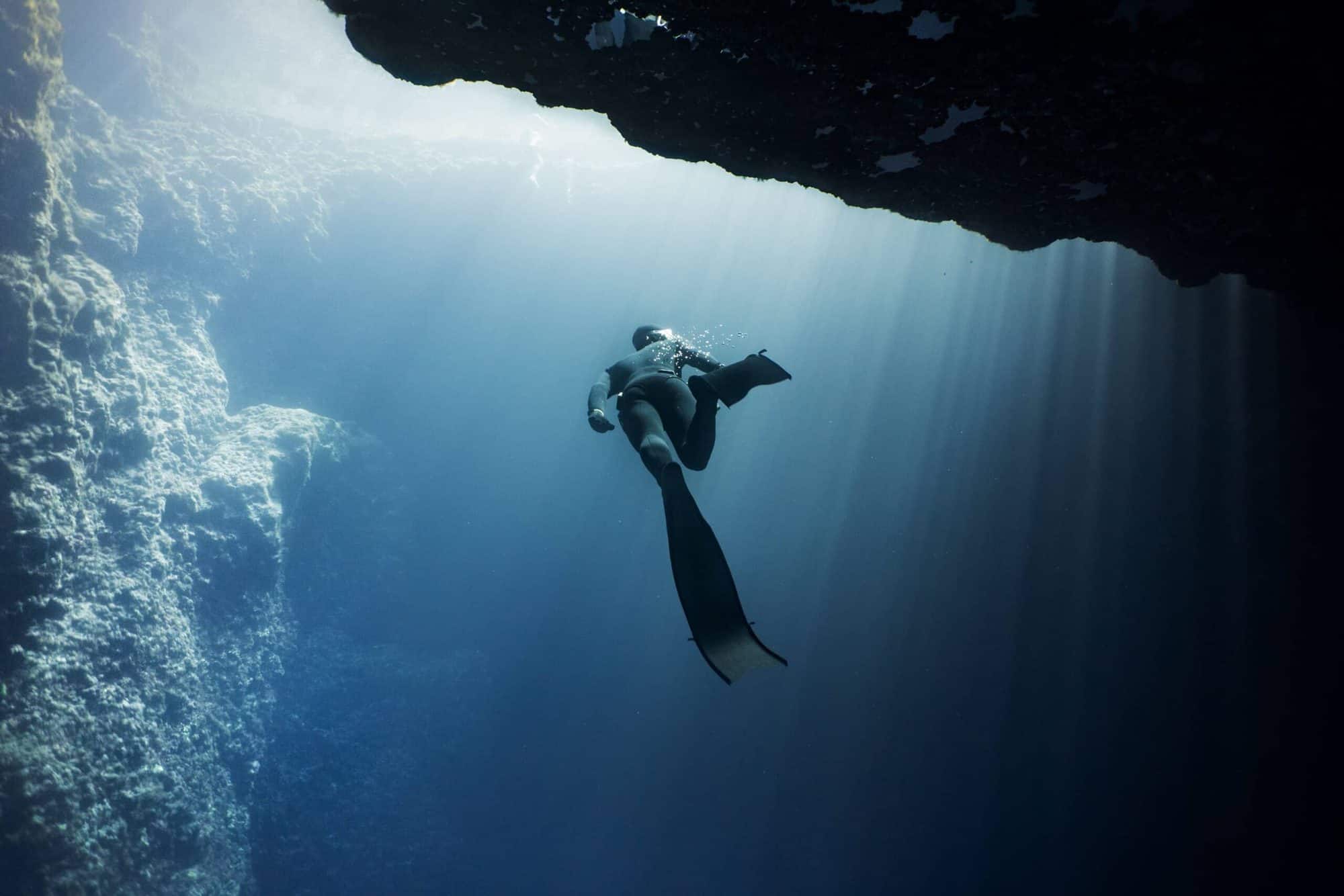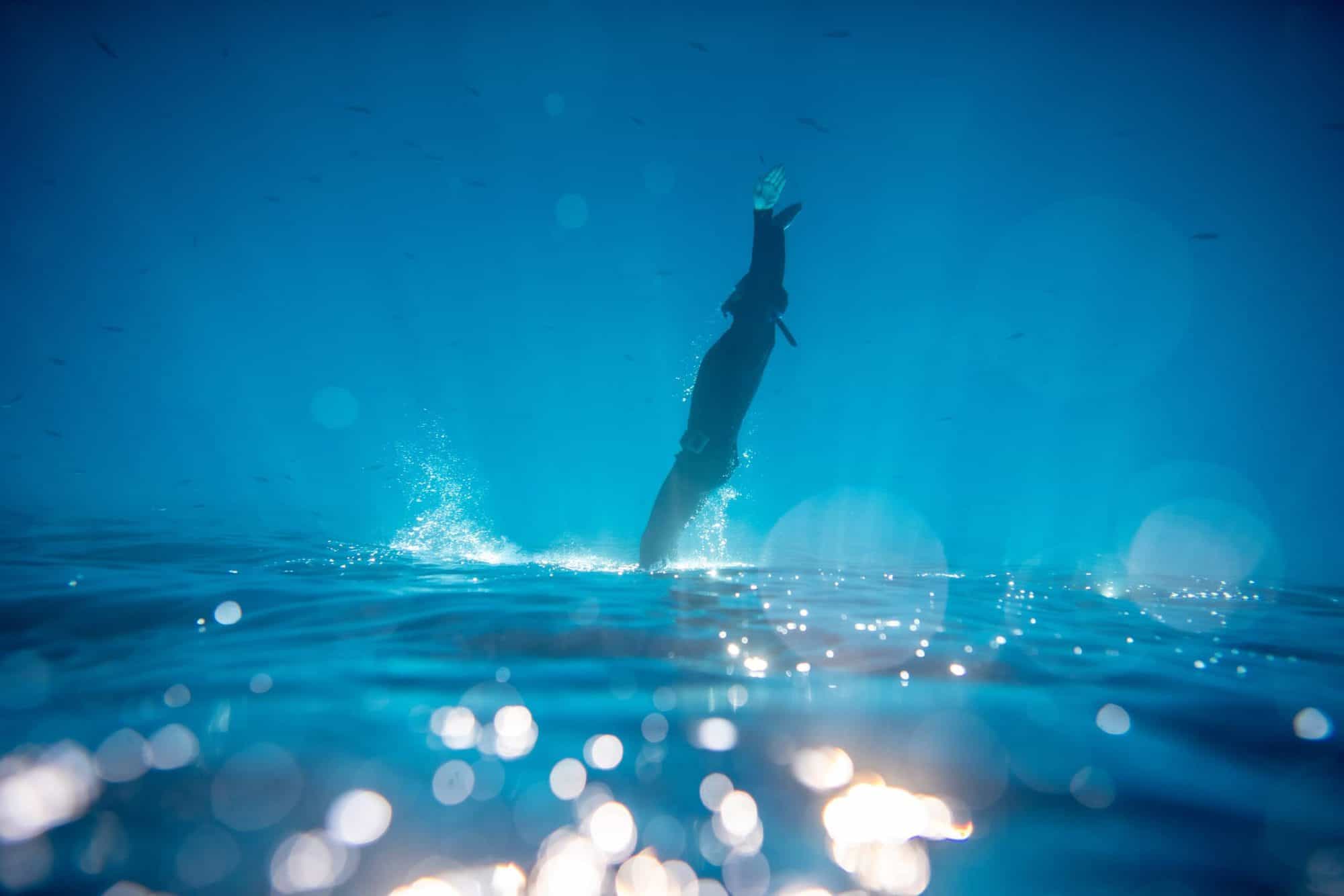Imagine taking the plunge beneath the waves without being constrained by the heavy apparatus of scuba gear. Just you and the silence of the underwater world and the incredible feeling of pushing yourself to the limits.
The ultimate connection between man and water, freediving is appropriate for anyone looking to challenge themselves and explore the deep blue sea all on the power of your own breath. Practiced either recreationally or competitively, with the right training like breathing and equalisation techniques, you’ll be well on your way to exploring your inward power, discipline and control, while having fun.
If you want to discover more about this activity and how to get started, read on.
What is freediving?
Also known as breath-hold diving or skin diving, freediving is a form of underwater diving that relies on breath-holding until resurfacing as opposed to using breathing apparatus like in the case with scuba diving. So instead of using an air tank to help you breathe, you simply hold your breath for as long as you can until you return to the surface. It might sound that freediving is similar to snorkelling, however, there are differences between the two. Both disciplines use a mask, snorkel and fins, but freediving will alway involve breath-holding no matter how deep you go. How long you stay underwater and the depth you can achieve will greatly depend on your aquatic abilities and how well you have trained for it.
And while freediving may conjure images of superhumans exploring the bottom of the sea for minutes in one breath, freediving is more common than you may have thought, used in a number of activities ranging from spearfishing and underwater photography to a range of water sports like synchronised swimming, underwater football, rugby and hockey, as well as competitive and non-competitive freediving.
When did freediving begin?
A discipline as old as time itself, freediving’s history is a long and interesting one. Humans first started freediving out of necessity, particularly for retrieving food and items like sponges and pearls that they could trade, as well as to reclaim sunken valuables, while it was also practiced to help during military campaigns. In Ancient Greece, breath-holding divers would descend to depths of up to 30 metres to collect sponges or to harvest red coral, using weights of as much as 15kg to speed up the descent.
Around 2,000 years ago, what were known as ama divers in Japan used freediving to collect pearls. In fact, for thousands of years, most seawater pearls were retrieved by freedivers working in the Indian Ocean, particularly in areas such as the Persian Gulf, the Read Sea and in the Gulf of Mannar. Pearling was also popular in places like the Philippines, Qatar, Bahrain, India and the Gulf of Mexico.
Freedivers were also used in warfare to disassemble underwater barricades or to scout out the seabeds when ships were approaching enemy harbours.
Are there different types of freediving?
Depending on your goals and what you are looking to achieve, you may choose to dive for time, depth or distance. As a new freediver, consider experimenting with a variety of disciplines with an instructor so that you can decide what your freediving objectives are.
Yet, freediving doesn’t only have a competitive side to it. Aimed at purely enjoying your underwater surroundings and becoming one with nature, recreational diving has many purposes be it to get closer to marine life, to explore underwater photography or to give wreck diving a go. Regardless of your recreational goal, freediving for leisure has many benefits and can improve your physical shape, while boosting your psychological and emotional state.
Below is a breakdown of the different freediving disciplines, many of which are also practiced competitively.
Mainly carried out in open water
Free immersion (FIM)
This discipline challenges freedivers to descend as deep as they can, while it enables them to better control their descent by pulling themselves down and then up through a rope without kicking along a weighted line. No fins or other types of propulsion devices are used. Beginner freedivers find this discipline particularly enjoyable since it is easy to control speed, equalisation and body positioning in a controlled environment. In fact, this is sometimes used as a warmup for the constant weight with or without fins disciplines.
World record: According to the Guiness World Record, the deepest dive in the free immersion (FIM) discipline by a male freediver is 125 metres, held by Alexey Molchanov that took place on July 24, 2018 at the Vertical Blue freediving competition at Dean’s Blue Hole on Long Island in The Bahamas.
Constant weight (CWT) with/without fins
One of the most common depth versions of freediving, during the constant weight discipline the diver descends the water using either bi-fins or a monofin and a small amount of weight without pulling on any guide ropes or changing the weight used. One of the deepest disciplines allowed in competitions, the diver kicks down to get to the desired depth, then stops kicking and freefalls downwards.
Another version of this discipline is the constant weight freediving with no fins. As its name implies, the diver attempts to reach the desired depth using only the strength of their muscles and the right swimming technique to descend as much as possible. No aids are allowed what’s so ever which means that the descent is slower, making this one of the most difficult forms of freediving since the diver needs to achieve the perfect coordination between propulsion, equalisation and buoyancy.
World record: The deepest constant weight freedive with bi-fins by a male is at 113 metres achieved by Alexey Molchanov on November 26, 2020 at the AIDA Freediving World Competition – COVID-19 Special Edition in Sharm el-Sheikh, Egypt.
Variable weight
Divers in this category use a heavy sled which is attached to vertical ropes to pull them downwards at an extremely rapid rate. This helps to maximise depth-time and limits wasting precious oxygen while swimming during the descent. Once the diver is ready to surface, they lose the weight and swim up or pull on the rope. Due to the quick descent, equalisation is far harder to achieve and so as expected, this is a discipline for the more experienced freedivers.
World record: The deepest freediving variable weight by a female diver is 130 metres, achieved by Nanja van de Broek in Sharm El-Sheikh, Egypt in 2015. Van de Broek broke the record of legendary freediver Natalia Molchanova, who had previously set the record at 127 metres.
No Limits Freediving (NLT)
One of the most extreme disciplines of freediving for depth and perhaps one of the most dangerous forms of the sport, NLT uses a weight, either in the form of a sled or platform, to take the diver as deep as possible. Then once the desired depth has been achieved, the diver uses a buoyancy device, such as inflating a gas powered balloon which helps them surface. No swimming is involved so divers can descend to greater depths than in other disciplines.
World record: The current no-limits world record holder is Herbert Nitsch who achieved a depth of 214 meters on June 6, 2012, in Santorini, Greece
Pool disciplines used to train for open water
Apnea
Apnea is the medical term used to describe slowed or stopped breathing. Typically associated with the medical condition known as sleep apnea, in freediving and other forms of water sports the term refers to the voluntary breath-holding while keeping the face below the surface of the water. There are two types of apneas, static (STA) and dynamic apnea.
- Static apnea (STA) – with this discipline the aim is to hold your breath for as long as possible while lying on the surface of the water and without swimming any distance so as to conserve oxygen. STA along with constant weight with fins is one of the original competition disciplines and training for it regularly has many benefits like improving your overall apnea ability and building your confidence, while it serves as great preparation for long and deep dives in open water. STA is also a mental challenge where the drive must manage the natural urge to breathe for as long as possible.
- Dynamic apnea – contrary to static apnea, this discipline requires the diver to swim underwater in a horizontal direction as far as possible with a single breath. A combination of swimming, breath-holding and mental control, during dynamic apnea the diver can swim with bi-fins, monofin or no fins. Considered the ideal training for those who cannot train in the sea during the cold winter months or for those who simply don’t have access to the open water, dynamic apnea is often practiced in a swimming pool. Working on your technique and fitness in a safe and controlled environment, makes it easier to keep track of your progress.
Which are some of the most popular freediving techniques and skills?
Just like any other physical activity, freediving also demands some preparation and mastering certain skills before you even hit the water. You’ll need to know how to breathe leading up to a dive, as well as how to prepare yourself beforehand, how to best manage air during a dive and how to recover your breath afterwards, while you’ll also need to learn how to equalise, in other words how to compensate for the reduction of air volume in the sinus and middle ear due to pressure. Ultimately, freediving takes discipline, practice and physical conditioning so that your freediving will not only be more effective, but also more enjoyable.
Hold-Breath Techniques
Take a deep breath and you’ll notice that your chest is the part of your body that rises and falls. Most humans breathe deeply into their chest, typically utilising only the top ⅓ of their lungs, but with freediving the aim is to take one full breath by first breathing into your belly using your diaphragm.
Mammalian Dive Reflex
A physiological response triggered by water temperature pressure and CO2 build up, the Mammalian Dive Reflex (MDR) is a reflex hard wired into our genetic makeup and is seen in all kinds of mammals. MDR slows our heartbeat and focuses blood flow to our lungs and other vital organs, allowing freedivers to dive for extended periods of time under pressure.
Gases in our body
Despite popular belief, our urge to breathe does not stem from our lack of oxygen but rather our ability to tolerate CO2, also known as our CO2 threshold and it is this threshold that gives us the natural urge to breathe. Usually our CO2 tolerance is low, however, with regular practice of safe, relaxed and repetitive breath-holding, you can build your CO2 tolerance.
Equalising
Depth and pressure go hand in hand and the deeper you descend in the water, the more the pressure, while the air spaces in our body get smaller. Unless you equalise – add air into these spaces as pressure underwater builds up so that they retain surface-level volume – your ears will hurt and this could lead to injury. There are two methods for equalising ear pressure. The first, known as the Valsalva maneuver, involves pinching your nose and trying to exhale against the pinched nose. The other is known as the Frenzel maneuver. With this method you use the back of your tongue to increase pressure in the oral and nasal cavities, all the while pinching your nose.
Breathing before and after a dive
There are different methods of breathing before and after a dive. For instance, the best and most common way to both set your breath and state of mind before a freediving session is through what is called tidal volume. This refers to the amount of air inhaled and exhaled during normal breathing just as when you are reading a book or watching TV. Usually breathing is very soft, with minimal air coming in and out. One way to achieve this state is through body scanning – a mindfulness technique that focuses awareness on the body to distract the mind.
On the other hand, for your last breath just before you go underwater, you should exhale until comfortable and then inhale fresh air as far as your lungs will go. This becomes even more effective if you expand your stomach to fill the lower region of your lungs and open your mouth wide to fill the upper part. Once you have resurfaced after a dive, you should quickly exhale a small amount of air and then take quick and deep breaths in, then repeat this process until your breathing returns to normal.
Duckdive
A technique originally used by surfers to catch the waves, in freediving duckdiving is the first step to getting into the water and is one of the most efficient methods of diving down to depth without having to use weights or a rope in the discipline of constant weight. To perform a duckdive you have to enter the water head first and push your body down until you form a vertical line.
What are some essential freediving equipment?
Technically sporting just your swimsuit should suffice to enjoy freediving, but owning some basic equipment like a mask, fins and exposure suits can make your dives more comfortable, most especially if you have to endure different water conditions.
Here are some items that you might find worth investing in:
- Mask – choose one that is low volume for easier equalisation, with clear lenses, nose pocket and a comfortable silicone seal around the face.
- Fins – fins can help you cover more ground, making your diving easier. Bi-fins, in other words, a pair of fins, are easier to maneuver in the water and are ideal for recreational diving. They usually come in long lengths, with enclosed feet holes and fin retainers around the ankles, while they are available in plastic, carbon fibre or fibre glass. Monofins are best for depth, distance and speed, however, you must use your entire body to propel through the water.
- Weightbelt – usually worn around the hips, these should be flexible but tight and should be evenly spaced for hydrodynamics in the water.
- Exposure suits – whether a wetsuit, pool suit or a dive skin, these can help you move better in the water, while offering protection against the cold water, the sun and marine hazards such as jellyfish. You may also want to consider using gloves to protect your hands from the cold.
Is freediving dangerous?
Freediving is often portrayed as an extreme, adrenaline-inducing and dangerous pursuit, but this is far from the truth. With the appropriate training and a good freediving course, coupled with some common sense like following basic safety rules and staying within your limits, you can enjoy freediving safely.
Here are some safety tips:
- Use the buddy system: Never dive alone and instead, bring your buddy with you whenever you head out to the water. In fact, the buddy system is crucial, so you should never disregard it. Ideally your buddy should match your freediving level and should be fully knowledgeable of safety principles and what to do in case of an emergency.
- Don’t leave the line: The line is there to guide you and to help your buddy locate you in case of an emergency. Going off course is just a recipe for disaster so you should never leave the line no matter what.
- Craft a plan: Whether you’re off to freedive just with your buddy or with an entire party, make sure you let them know what the day’s dive plan is and whether you’re planning any deep dives.
Use correct weighting: Weights are an excellent accessory to have since they can make swimming to greater depths easier. Yet, if you’re overweighting yourself, this could be quite risky. Make sure you weight yourself for neutral buoyancy at around 10 metres and use a weighting system you can quickly release.
Remember to relax and enjoy yourself: panicking while in the water can be dangerous. This is why relaxation is key to freediving. Deep, slow and calm breaths help lower your heart rate so that your body can conserve oxygen like when practicing tidal volume mentioned earlier on. Make sure you are prepared before each freediving session.
Don’t overdo it: freediving can be a lot of fun, while it can be incredibly rewarding each time you achieve a new milestone. But don’t get tempted to push yourself beyond your limits. Doing so can have adverse consequences.
Take a freediving course
There’s no better way of getting started in freediving than with a good course. From learning how to relax your body through different breathing and relaxation techniques to understanding the safety aspect of the sport, mastering important freediving skills and discovering what your body is capable of, with a course you’ll be introduced to the basic elements of freediving, while enjoying the beauty of what surrounds you in the water.
Have a look at the courses we offer and why we have opted for the Molchanovs Education programme.


